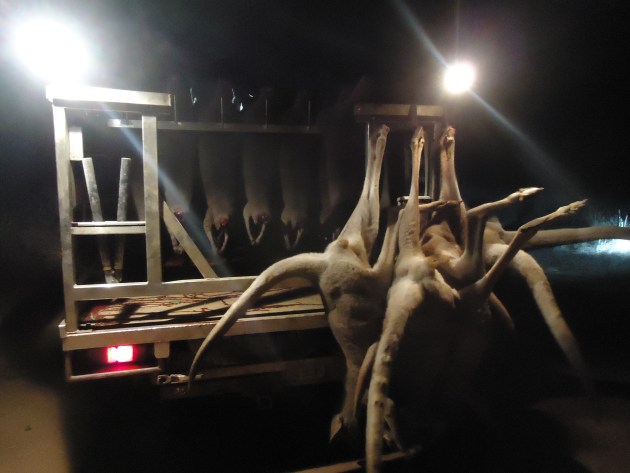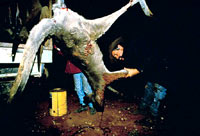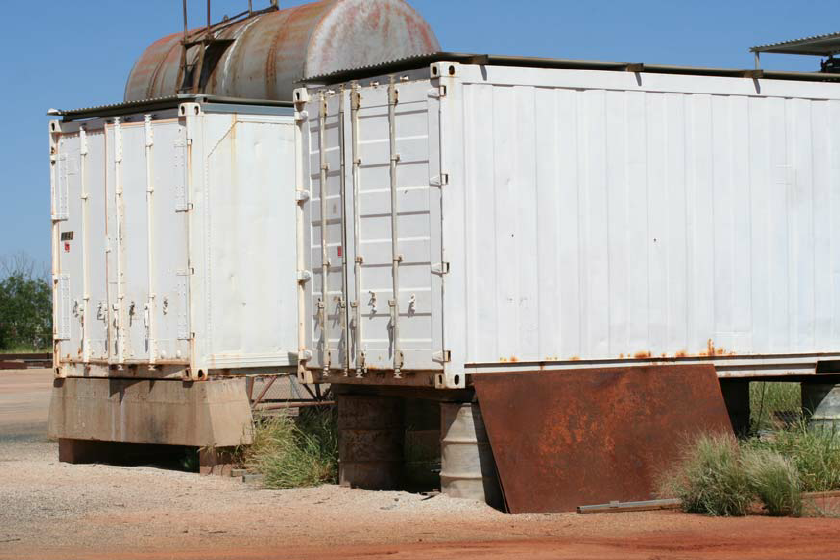Kangaroo meat is sold as a healthy red meat. Videos and photos depict clean, modern, refrigerated plants where the carcasses are processed for sale. What isn’t advertised is the inhumane way kangaroos are slaughtered, nor the unhygienic conditions in which kangaroos are hunted, gutted and transported.
The public is being fed false and misleading information so that an industry can operate in appalling conditions.
Kangaroos are shot in the middle of the night in remote rural locations. The carcasses are stowed in the back of an open truck. As the truck travels through the night, dust and flies cover the carcasses. By law, kangaroo hunters only have to take their harvest to a refrigerated chiller room within two hours of the sun rising. This law means that kangaroo carcasses can be hanging on the back of a dirty truck in the open air for eight hours.
In Australia, during summer, night time temperatures can remain between 25°C and 35°C. Kangaroo carcasses can be hanging on the back of dirty trucks, getting covered in flies and dust, for up to eight hours in temperatures of 25°C to 35°C.

An animal’s body begins to decompose immediately after death. The body soon gives off a foul odor and attracts insects. The hotter the temperature, the faster the rate of decomposition.
From the moment of death flies are attracted to bodies. Without the normal defences of a living animal, blowflies and house flies are able to lay eggs around wounds and natural body openings (mouth, nose, eyes, anus, genitalia). These eggs hatch and move into the body, often within 24 hours (source: Australian Museum).
Although the body shortly after death appears fresh from the outside, the bacteria that before death were feeding on the contents of the intestine begin to digest the intestine itself. They eventually break out of the intestine and start digesting the surrounding internal organs. The body’s own digestive enzymes (normally in the intestine) also spread through the body, contributing to its decomposition (source: Australian Museum).
Kangaroo hunters often leave kangaroo carcasses lying on the ground, touching each other, allowing for cross-contamination, and resulting in the bodies being covered by dirt and insects.

A Shot in the Dark: A Report on Kangaroo Harvesting by Dror Ben-Ami, PhD, 2009 states that this report exposes the realities of the kangaroo industry which include extensive and alarmingly unhygienic practices, unacceptable suffering of both young kangaroos and adults and the manufacture of false hope that kangaroo harvesting will alleviate environmental degradation in rural areas.
As well as the problems associated with the shooting of unhealthy individuals, further risks of bacterial infection arise due to the sometimes excessive periods of time between an animal being shot and processed and the carcass being placed in cold storage. Shooters often travel long distances for their night’s kill and in summer there are few hours of darkness. Kangaroos are gutted and bled in the field and then hung on an open air truck for the duration of the night (CSIRO 2007). The resulting long delay between processing (in the field) and cold storing increases the likelihood of bacterial contamination.
In relation to disease, the report indicates that a number of epidemics have been reported in wild kangaroos. The most worrying in relation to human health-risk is an undiagnosed fatal epidemic. There have been several reported incidents of sporadic “die-offs” in large kangaroo populations in central and western Queensland and north western New South Wales dating back to the 1950’s.
Kangaroos are susceptible to disease. One of the modern diseases to infect kangaroos is unknown to experts. Commercial harvesting of wild kangaroos takes place in the middle of the night in remote rural locations. Diagnosing kangaroos with disease is the responsibility of the commercial hunter. This diagnosis occurs in a split second in the middle of the night from up to 250 metres away behind the sights of high-powered weapons. Hunters are required to kill diseased kangaroos but not include them in the harvest for use as meat. This seems like a huge, risky burden to place on the commercial hunter. If he gets it wrong, or simply wants the money for the diseased carcass, then this diseased meat ends up in the supermarket for human consumption. Some diseases that effect kangaroos can be easily transferred to humans.

The report continues: Evidence collected by Animal Liberation NSW (Appendix 1, Sibraa 2009) from various remote chillers in NSW and Queensland suggests that chillers are often unhygienic and use a range of practices which violate both the National Code of Practice for the Humane Shooting of Kangaroos and Wallabies for Commercial Purposes (Department of the Environment Water Heritage and the Arts 2008) and the Australian Standard for the Hygienic Production of Game Meat for Human Consumption (CSIRO 2007). This evidence documented such practices as:
1) hanging carcasses touching the floor;
2) fresh blood on the floor;
3) old dried blood that had not been washed away on the floor;
4) carcasses over-packed and touching one another;
5) no sterile zone due to only one point of entry into the chillers;
6) tags on carcasses showing that they are 12 and 13 days old; and
7) implement used for bludgeoning joeys (young kangaroos) with caked blood on the end.

According to the report, unhygienic conditions remain a big problem: There is a history of chillers in unhygienic conditions and the phenomenon seems to be widespread. During a South Australian Kangaroo Management Program public meeting Eddie Anndriessen, an AQIS meat inspector, stated that in a follow-up inspection of 15 chillers throughout South Australia which took place two years after the initial inspection, he found: “not a single chiller box (Macro Meats and other processors SA, sic) that is up to standard, with most being unclean or uncleanable; a big incidence of fly-struck meat is going down to Adelaide; airflow floors are not being cleaned thoroughly; there’s still congealed blood and muck; most of the dirty water is washed out from the front with the bones, instead of being plumbed to a drain; no connection to potable water, only one chiller box had chemicals for cleaning; and that there were still kangaroo feet in the surrounds from two years ago” (The South Australian Kangaroo Management Program 1998).
Accompanying the report was a letter from Max Dulumunmum Harrison, Aboriginal Elder from Yuin Country. The author of the letter is clearly against the commercial harvest of kangaroos for many reasons. One of those reasons is: I have a number of concerns of which you may not be aware. The first relates to the manner in which Kangaroos are harvested for consumption. Current practices are likely to be harmful to human health as, traditionally, when Kangaroos were hunted and killed, they were immediately thrown on a fire and cooked. This prevented both the build up of harmful bacteria in the meat and a deterioration in its quality. Immediate cooking also meant that the nutritional value of the meat was retained (Kangaroo meat contains one of the highest food sources of iron). Today, the Kangaroo is killed and then transported long distances to processing factories during which time the build [up] of harmful bacteria is likely to occur resulting in unhygienic meat which has lost most of its nutritional value.
In Australia, kangaroo meat is not tested for known kangaroo zoonotic pathogens such as Toxoplasma gondii, which is recognised as a serious long-term health risk to humans.
Research shows that wild and captive kangaroos can carry salmonella. Meat intended for human and pet consumption has been associated with high rates of Salmonella contamination. From time to time, kangaroo meat products are the subject of health and safety recalls.
Russia suspended importation of kangaroo meat in 2008 due to unacceptably high levels of E.coli bacteria. Trade was reopened in November 2012 and suspended again in may 2014, once again due to unacceptably high levels of E.coli bacteria.
Kangaroo meat is sold as the healthy alternative. In truth, eating kangaroo meat poses a huge health risk due to potential contamination of bacteria and disease.
The above image was uploaded by a kangaroo shooter, who stated, “This is me fully loaded with 56 roos on ready to head to town and unload into the chiller. There is over 1300kg on the land cruiser and it bounces around the paddock all night like this.”
For further information:
A Shot in the Dark: A Report on Kangaroo Harvesting
Kangaroo Meat Fails Basic Hygiene Tests
Roo Meat Still Contaminated
NSW Kangaroo Meat Fails Basic Hygiene Tests
Kangaroos At Risk
Food Safety News
Prevalence of Salmonellain Fecal Samples of Western Grey Kangaroos (Macropus Fuliginosus)


